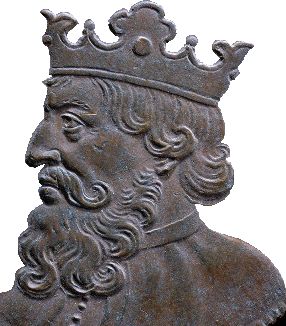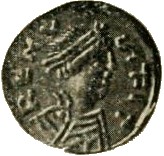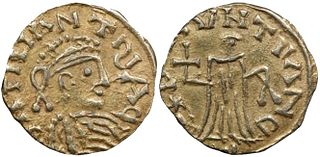Related Research Articles
The 560s decade ran from January 1, 560, to December 31, 569.

Chlothar II, sometime called "the Young", , was king of Neustria and king of the Franks, and the son of Chilperic I and his third wife, Fredegund. He started his reign as an infant under the regency of his mother, who was in an uneasy alliance with Chlothar's uncle King Guntram of Burgundy, who died in 592. Chlothar took power upon the death of his mother in 597; though rich, Neustria was one of the smallest portions of Francia. He continued his mother's feud with Queen Brunhilda with equal viciousness and bloodshed, finally achieving her execution in an especially brutal manner in 613, after winning the battle that enabled Chlothar to unite Francia under his rule. Like his father, he built up his territories by seizing lands after the deaths of other kings.

Chilperic I was the king of Neustria from 561 to his death. He was one of the sons of the Frankish king Clotaire I and Queen Aregund.

Chlothar I, sometime called "the Old", also anglicised as Clotaire, was a king of the Franks of the Merovingian dynasty and one of the four sons of Clovis I.

Francia, also called the Kingdom of the Franks, Frankish Kingdom, Frankland or Frankish Empire, was the largest post-Roman barbarian kingdom in Western Europe. It was ruled by the Frankish Merovingian and Carolingian dynasties during the Early Middle Ages. Francia was among the last surviving Germanic kingdoms from the Migration Period era.

Sigebert I was a Frankish king of Austrasia from the death of his father in 561 to his own death. He was the third surviving son out of four of Clotaire I and Ingund. His reign found him mostly occupied with a successful civil war against his half-brother, Chilperic.
Fredegund or Fredegunda was the Queen consort of Chilperic I, the Merovingian Frankish king of Soissons. Fredegund served as regent during the minority of her son Chlothar II from 584 until 597.

Charibert I was the Merovingian King of Paris, the second-eldest son of Chlothar I and his first wife Ingund. His elder brother Gunthar died sometime before their father's death. He shared in the partition of the Frankish kingdom that followed his father's death in 561, receiving the old kingdom of Childebert I, with its capital at Paris.

Saint Gontrand, also called Gontran, Gontram, Guntram, Gunthram, Gunthchramn, and Guntramnus, was the king of the Kingdom of Orléans from AD 561 to AD 592. He was the third-eldest and second-eldest-surviving son of Chlothar I and Ingunda. On his father's death in 561, he became king of a fourth of the Kingdom of the Franks, and made his capital at Orléans. The name "Gontrand" denotes "War Raven".
In the medieval Roman Catholic church there were several Councils of Tours, that city being an old seat of Christianity, and considered fairly centrally located in France.

Germain was the bishop of Paris and is venerated as a saint in both the Catholic Church and the Eastern Orthodox Church. According to an early biography, he was known as Germain d'Autun, rendered in modern times as the "Father of the Poor".

Venantius Honorius Clementianus Fortunatus, known as Saint Venantius Fortunatus, was a Latin poet and hymnographer in the Merovingian Court, and a bishop of the Early Church who has been venerated since the Middle Ages.

Radegund was a Thuringian princess and Frankish queen, who founded the Abbey of the Holy Cross at Poitiers. She is the patron saint of several churches in France and England and of Jesus College, Cambridge.
Basina, was a Frankish princess, the daughter and youngest child of Chilperic I, King of Soissons, and his first wife, Audovera. After surviving the assassination of her immediate family, she became a nun. She later helped to lead a rebellion by a group of the nuns, which became a scandal throughout the region. This event was chronicled by the bishop and saint, Gregory of Tours, who was one of the bishops chosen to settle the matter.
The First Council of Orléans was convoked by Clovis I, King of the Franks, in 511. Clovis called for this synod four years after his victory over the Visigoths under Alaric II at the Battle of Vouillé in 507. The council was attended by thirty-two bishops, including four metropolitans, from across Gaul, and together they passed thirty-one decrees. The bishops met at Orléans to reform the church and construct a strong relationship between the crown and the Catholic episcopate, the majority of the canons reflecting compromise between these two institutions.
Saint Prætextatus, also spelled Praetextatus, Pretextat(us), and known as Saint Prix, was the bishop of Rouen from 549 until his assassination in 586. He appears as a prominent character in Gregory of Tours’ Historia Francorum. This is the principal source from which information on his life can be drawn. He features in many of its most notable passages, including those pertaining to his trial in Paris and his rivalry with the Merovingian Queen Fredegund. The events of his life, as portrayed by Gregory of Tours, have been important in the development of modern understandings of various facets of Merovingian society, such as law, the rivalry between kings and bishops, church councils, and the power of queens.

The Church of Sainte-Radegonde is a medieval Roman Catholic church in Poitiers, France, dating from the 6th century. It takes its name from the Frankish queen and nun, Radegund, who was buried in the church. Considered a saint, the church became a place of pilgrimage by those devoted to her heavenly intercession. The current church, constructed from the 11th to 12th centuries, was built in a combination of Romanesque and Angevin Gothic architectural styles.

The Abbey of the Holy Cross was a French Benedictine monastery of nuns founded in the 6th century. Destroyed during the French Revolution, a new monastery with the same name was built in a nearby location during the 19th century for a community of Canonesses of St. Augustine of the Mercy of Jesus.

Saint-Césaire Convent, at first called Saint-Jean monastery, was a nunnery in the city of Arles in the south-eastern corner of the rampart. It was founded in 512 AD. Its name was later changed to Abbaye Saint-Césaire in honor of its first abbess, Caesaria of Arles, and it remained until the French Revolution. Later what remained of the buildings were used as a hospice.
Maroveus was the bishop of Poitiers in the late sixth century, between 565×573 and 590×594.
References
- ↑ Van Dam, Raymond. Saints and Their Miracles in Late Antique Gaul, Princeton University Press, 2011, p. 62 ISBN 9781400821143
- 1 2 Bennett, S.A., "Eufronius (2)", A Dictionary of Christian Biography, (William Smith, Henry Wace, eds.), J. Murray, 1880, p. 269
 This article incorporates text from this source, which is in the public domain .
This article incorporates text from this source, which is in the public domain . - ↑ Labande-Mailfert (dir.), Yvonne (1986–1987). "Histoire de l'abbaye Sainte-Croix de Poitiers : quatorze siècles de vie monastique" (in French). 4e sér. Mémoires de la Société des antiquaires de l'Ouest: 19.
{{cite journal}}: Cite journal requires|journal=(help) - ↑ Western Perspectives on the Mediterranean: Cultural Transfer in Late Antiquity and the Early Middle Ages, 400-800 AD, (Andreas Fischer, Ian Wood, eds.), A&C Black, 2014, p. 125 ISBN 9781472502124
- ↑ Thierry, Augustin. History of the Conquest of England by the Normans, Cambridge University Press, 2011, p. 25, n.2 ISBN 9781108030236
- ↑ Bridgett, Thomas E., Britons, Picts, Scots, and Anglo-Saxons, C. Kegan Paul, 1881, p. 34
 This article incorporates text from this source, which is in the public domain .
This article incorporates text from this source, which is in the public domain . - ↑ Halfond, Gregory I., "War and Peace in the Acta of the Merovingian Church Councils", The Medieval Way of War: Studies in Medieval Military History in Honor of Bernard S. Bachrach, (G. I. Halfond, ed.) Ashgate Publishing, Ltd., 2015, p. 29 ISBN 9781472419606
- ↑ Heinzelmann, Martin. Gregory of Tours: History and Society in the Sixth Century, (Christopher Carroll, trans.), Cambridge University Press, 2001